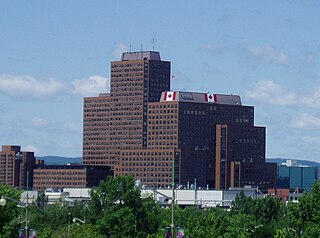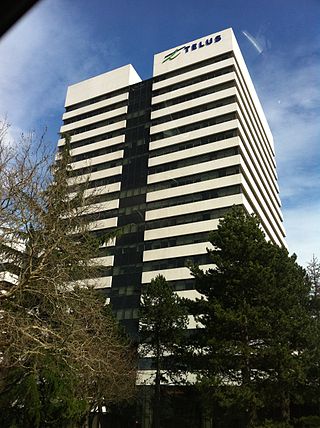Present-day telecommunications in Canada include telephone, radio, television, and internet usage. In the past, telecommunications included telegraphy available through Canadian Pacific and Canadian National.

The Canadian Radio-television and Telecommunications Commission is a public organization in Canada with mandate as a regulatory agency for broadcasting and telecommunications. It was created in 1976 when it took over responsibility for regulating telecommunication carriers. Prior to 1976, it was known as the Canadian Radio and Television Commission, which was established in 1968 by the Parliament of Canada to replace the Board of Broadcast Governors. Its headquarters is located in the Central Building of Les Terrasses de la Chaudière in Gatineau, Quebec.

GTE Corporation, formerly General Telephone & Electronics Corporation (1955–1982), was the largest independent telephone company in the United States during the days of the Bell System. The company operated from 1926, with roots tracing further back than that, until 2000, when it was acquired by Bell Atlantic; the combined company took the name Verizon.

Telus Communications Inc. (TCI) is the wholly owned principal subsidiary of Telus Corporation, a Canadian national telecommunications company that provides a wide range of telecommunications products and services including internet access, voice, entertainment, healthcare, video, smart home automation and IPTV television. The company is based in the Vancouver, British Columbia, area; it was originally based in Edmonton, Alberta, before its merger with BC Tel in 1999. Telus' wireless division, Telus Mobility, offers UMTS, and LTE-based mobile phone networks. Telus is the incumbent local exchange carrier in British Columbia and Alberta. Its primary competitors are Rogers Communications and Bell Canada. Telus is a member of the British Columbia Technology Industry Association.

Bell Canada is a Canadian telecommunications company headquartered at 1 Carrefour Alexander-Graham-Bell in the borough of Verdun, Quebec, in Canada. It is an ILEC in the provinces of Ontario and Quebec; as such, it was a founding member of the Stentor Alliance. It is also a CLEC for enterprise customers in the western provinces.
Automatic Electric Company was an American telephone equipment supplier primarily for independent telephone companies in North America, but also had a worldwide presence. With its line of automatic telephone exchanges, it was also a long-term supplier of switching equipment to the Bell System, starting in 1919. The company was the largest manufacturing unit of the Automatic Electric Group. In 1955, the company was acquired by General Telephone and Electronics (GT&E). After numerous reorganization within GTE, the companies assets it came under the umbrella of Lucent in the 1990s, and subsequently part of Nokia.
An incumbent local exchange carrier (ILEC) is a local telephone company which held the regional monopoly on landline service before the market was opened to competitive local exchange carriers, or the corporate successor of such a firm.
Bell MTS Inc. is a subsidiary of BCE Inc. that operates telecommunications services in Manitoba.

Mercury Communications was a national telephone company in the United Kingdom, formed in 1981 as a subsidiary of Cable & Wireless, to challenge the then-monopoly of British Telecom (BT). Although it proved only moderately successful at challenging BT's dominance, it led the way for new communication companies to attempt the same.
Northwestel Inc. is a Canadian telecommunications company that is the incumbent local exchange carrier (ILEC) and long-distance carrier in the territories of Yukon, the Northwest Territories, Nunavut, and part of Northern British Columbia. Originally established in 1979 by the Canadian National Railway from CN's northern telecommunications assets, it has been owned by BCE Inc. since 1988.
Alberta Government Telephones (AGT) was the telephone provider in most of Alberta from 1906 to 1991.

The breakup of the Bell System was mandated on January 8, 1982, by a consent decree providing that AT&T Corporation would, as had been initially proposed by AT&T, relinquish control of the Bell Operating Companies, which had provided local telephone service in the United States. This effectively took the monopoly that was the Bell System and split it into entirely separate companies that would continue to provide telephone service. AT&T would continue to be a provider of long-distance service, while the now-independent Regional Bell Operating Companies (RBOCs), nicknamed the "Baby Bells", would provide local service, and would no longer be directly supplied with equipment from AT&T subsidiary Western Electric.

Embarq Corporation was the largest independent local exchange carrier in the United States, serving customers in 18 states and providing local, long-distance, high-speed data and wireless services to residential and business customers. It had been formerly the local telephone division (LTD) of Sprint Nextel until 2006, when it was spun off as an independent company. Embarq produced more than $6 billion in revenues annually, and had approximately 18,000 employees. It was based in Overland Park, Kansas.
Verizon South, Inc. is a Verizon operating company providing local telephone services to portions of Virginia and North Carolina in the United States.
Centel Corporation was an American telecommunications company, with primary interests in providing basic telephone service, cellular phone service and cable television service.

CityWest Cable and Telephone Corporation, operating as CityWest, is a municipally-owned telecommunications holding company which provides telephone, cable television, and internet services in Prince Rupert, British Columbia, Canada and the surrounding regions. CityWest also purchased Monarch Cablesystems' assets, which were split between the former CityTel and Shaw Communications.

An independent telephone company was a telephone company providing local service in the United States or Canada that was not part of the Bell System organized by American Telephone and Telegraph. Independent telephone companies usually operated in many rural or sparsely populated areas.
Clearnet was a division of Telus Mobility launched in April 2011 to sell landline and mobile phone bundles in Western Canada. It was a revival of the Clearnet Communications brand name, which originally belonged to an independent cellular provider that was merged into Telus Mobility in 2000. Telus relaunched Clearnet as a discount provider with a "limited market trial" in Kelowna, British Columbia and Red Deer, Alberta.
This is a timeline of Telus Corporation, a publicly traded Canadian multinational holding company offering a range of telecommunications, health, safety, and security products and services. The company operates Telus Communications Inc., which offers telephony, television, data and Internet services, Telus Mobility, a division that offers wireless services, Telus Health, which operates companies that provide health products and services, and Telus International which operates worldwide, providing multilingual customer service outsourcing and digital IT services.

Telus Corporation is a Canadian publicly traded holding company and conglomerate, headquartered in Vancouver, British Columbia, which is the parent company of subsidiaries—Telus Communications, Telus Mobility, Telus Health, Telus Agriculture, and Telus International. Telus offers a range of telecommunications, health, safety, and security products and services. It is listed with the Toronto Stock Exchange. Telus Communications Inc. offers telephony, television, data and Internet services; Telus Mobility, offers wireless services; Telus Health operates companies that provide health products and services; and Telus International operates worldwide, providing multilingual customer service outsourcing and digital IT services.










